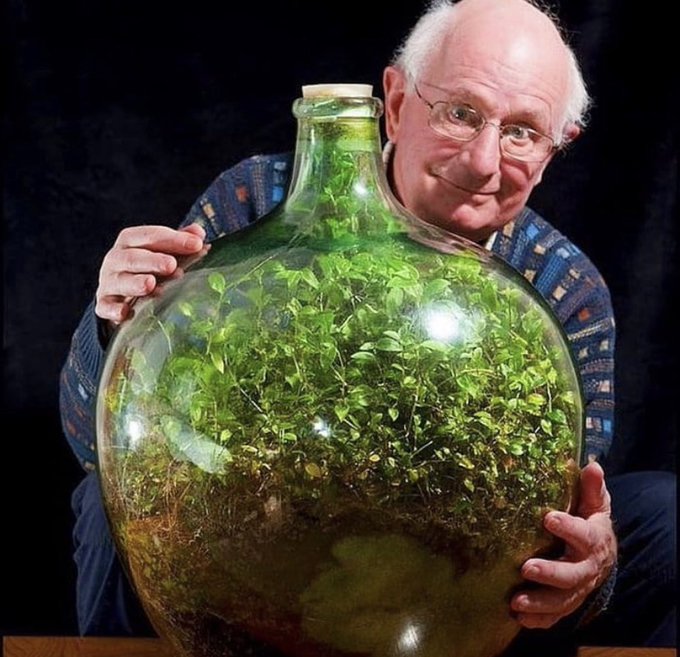In 1960, a young British man named David Latimer had a unique idea to experiment with a closed, self-sustaining ecosystem. He planted a seedling in a large glass bottle, filled a quarter of the bottle with water, and tightly sealed it. He then left the bottle undisturbed, setting the stage for a long-term experiment that would not only yield fascinating results but also inspire further studies on self-sustaining ecosystems.
In 1972, 12 years later, David Latimer decided to open the bottle to add more water. To his surprise, he found that there was no need for additional care or watering. The small garden inside the bottle had somehow managed to continue growing and thriving without any external intervention. It was as if the plant had magically adapted to the sealed conditions and sustained itself.
This bottle, which has been a self-sustaining and balanced ecosystem for over 60 years, serves as a model for the remarkable sustainability of nature. It demonstrates how a plant can survive and flourish in a completely enclosed environment, drawing on its own resources without any outside help.
How Does This Self-Sustaining Ecosystem Work?
The ecosystem inside Latimer’s bottle is a closed system, where no external materials enter. It relies on two primary components: the plant inside the bottle and the bacteria and microorganisms in the compost within the bottle. These two elements interact with each other to create a balanced and sustainable cycle.
The plant inside the bottle uses sunlight to carry out photosynthesis. In this process, the plant absorbs carbon dioxide (CO2) from the air and, with the help of sunlight, converts it into oxygen and simple sugars. The oxygen is released into the environment inside the bottle and helps support the other living organisms inside.
Meanwhile, the bacteria in the compost break down the dead plant matter. These bacteria convert organic material into nutrients, which are used by the plant for growth. Additionally, this process produces carbon dioxide, which the plant then uses for photosynthesis.
This interaction between the plant and the bacteria creates a sustainable biological cycle. The plant requires carbon dioxide for photosynthesis, which it absorbs from the air. At the same time, the bacteria break down plant matter, releasing nutrients and carbon dioxide that are essential for the plant’s continued growth.
Scientific and Environmental Implications of This Experiment
David Latimer’s experiment, in addition to its visual intrigue and wonder, has important scientific implications that can help us understand the functioning of natural ecosystems. One of the key concepts that emerge from this experiment is the idea of “closed systems” or “self-sustaining ecosystems.” In these systems, all the resources needed by living organisms are provided internally, without reliance on external inputs.
These systems are designed in such a way that they do not depend on outside resources, and all nutrients and energy required for the survival of living organisms come from internal cycles. This model of ecosystems has gained increasing attention as a potential framework for creating sustainable systems in the outside world.
The Role of Self-Sustaining Ecosystems in Environmental Futures
Today, with growing concerns about climate change, resource scarcity, and the need for efficient energy use, the study and design of self-sustaining, sustainable systems is more important than ever. Latimer’s experiment can serve as an inspiring example for creating sustainable ecosystems in various fields such as agriculture, architecture, and even indoor spaces.
In today’s world, there is a growing trend to use plants in buildings for purposes such as air purification, energy production, and even food provision. Similarly, the concept of self-sustaining ecosystems can play an important role in designing smart, sustainable cities.
Similar Experiments and Future Developments
Following the success of David Latimer’s experiment, similar experiments have been conducted around the world. Many researchers and enthusiasts have begun creating similar systems where plants, bacteria, and other living organisms interact in closed environments to establish a sustainable ecosystem. These experiments have demonstrated that with the right conditions and balance, it is possible to create self-sustaining systems on a larger scale.
In the future, such systems could be used in larger projects such as residential spaces, sustainable cities, or even space missions. For instance, NASA is currently researching ways to create closed systems that can provide sustainable resources like water, oxygen, and food in space stations or spacecraft. Similar experiments to Latimer’s could help pave the way for these larger projects.
Conclusion: The Importance of Preserving and Expanding Sustainable Ecosystems
Ultimately, David Latimer’s experiment is not only a fascinating scientific endeavor but also a demonstration of nature’s ability to create balance in enclosed environments. The experiment shows how it is possible to create a sustainable, self-sufficient ecosystem that can thrive and evolve naturally without human intervention. This kind of thinking and approach, especially in today’s world with environmental challenges, can inspire the design of systems that use resources efficiently and contribute to the sustainability of our planet.
Looking ahead, the study of self-sustaining ecosystems and their potential applications could provide solutions to global environmental challenges and help us move towards a more sustainable future.
Resources:

